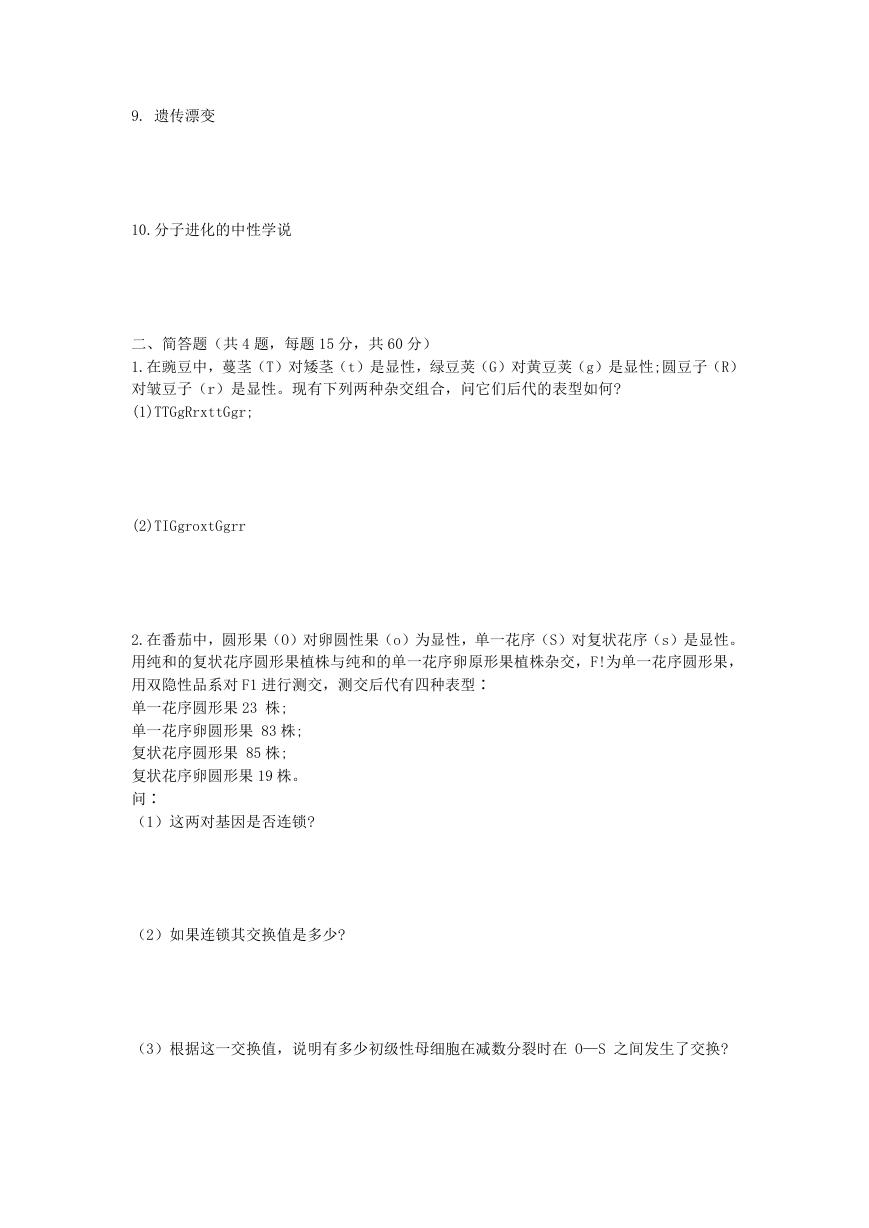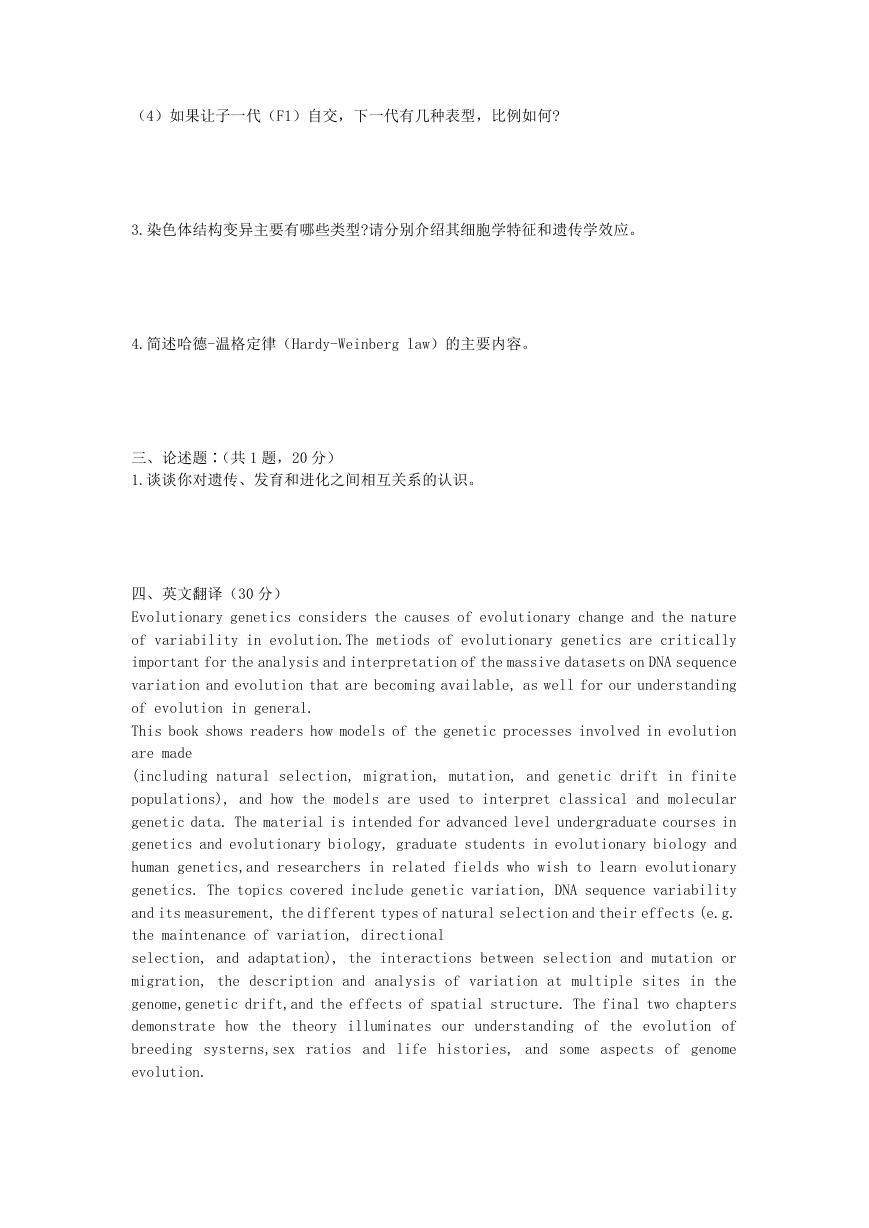2016 年安徽师范大学普通遗传学考研真题
一、名词解释(共 10 题,每题 4 分,共 40 分)
1. 性状
2.基因型与表现型
3. 基因组
4. 基因互作
5. 母性遗传
6.移码突变
7. 转座因子
8. 基因水平转移
�
9. 遗传漂变
10.分子进化的中性学说
二、简答题(共 4 题,每题 15 分,共 60 分)
1.在豌豆中,蔓茎(T)对矮茎(t)是显性,绿豆荚(G)对黄豆荚(g)是显性;圆豆子(R)
对皱豆子(r)是显性。现有下列两种杂交组合,问它们后代的表型如何?
(1)TTGgRrxttGgr;
(2)TIGgroxtGgrr
2.在番茄中,圆形果(O)对卵圆性果(o)为显性,单一花序(S)对复状花序(s)是显性。
用纯和的复状花序圆形果植株与纯和的单一花序卵原形果植株杂交,F!为单一花序圆形果,
用双隐性品系对 F1 进行测交,测交后代有四种表型∶
单一花序圆形果 23 株;
单一花序卵圆形果 83 株;
复状花序圆形果 85 株;
复状花序卵圆形果 19 株。
问∶
(1)这两对基因是否连锁?
(2)如果连锁其交换值是多少?
(3)根据这一交换值,说明有多少初级性母细胞在减数分裂时在 O—S 之间发生了交换?
�
(4)如果让子一代(F1)自交,下一代有几种表型,比例如何?
3.染色体结构变异主要有哪些类型?请分别介绍其细胞学特征和遗传学效应。
4.简述哈德-温格定律(Hardy-Weinberg law)的主要内容。
三、论述题∶(共 1 题,20 分)
1.谈谈你对遗传、发育和进化之间相互关系的认识。
四、英文翻译(30 分)
Evolutionary genetics considers the causes of evolutionary change and the nature
of variability in evolution.The metiods of evolutionary genetics are critically
important for the analysis and interpretation of the massive datasets on DNA sequence
variation and evolution that are becoming available, as well for our understanding
of evolution in general.
This book shows readers how models of the genetic processes involved in evolution
are made
(including natural selection, migration, mutation, and genetic drift in finite
populations), and how the models are used to interpret classical and molecular
genetic data. The material is intended for advanced level undergraduate courses in
genetics and evolutionary biology, graduate students in evolutionary biology and
human genetics,and researchers in related fields who wish to learn evolutionary
genetics. The topics covered include genetic variation, DNA sequence variability
and its measurement, the different types of natural selection and their effects (e.g.
the maintenance of variation, directional
selection, and adaptation), the interactions between selection and mutation or
migration, the description and analysis of variation at multiple sites in the
genome,genetic drift,and the effects of spatial structure. The final two chapters
demonstrate how the theory illuminates our understanding of the evolution of
breeding systerns,sex ratios and life histories, and some aspects of genome
evolution.
�






 2023年江西萍乡中考道德与法治真题及答案.doc
2023年江西萍乡中考道德与法治真题及答案.doc 2012年重庆南川中考生物真题及答案.doc
2012年重庆南川中考生物真题及答案.doc 2013年江西师范大学地理学综合及文艺理论基础考研真题.doc
2013年江西师范大学地理学综合及文艺理论基础考研真题.doc 2020年四川甘孜小升初语文真题及答案I卷.doc
2020年四川甘孜小升初语文真题及答案I卷.doc 2020年注册岩土工程师专业基础考试真题及答案.doc
2020年注册岩土工程师专业基础考试真题及答案.doc 2023-2024学年福建省厦门市九年级上学期数学月考试题及答案.doc
2023-2024学年福建省厦门市九年级上学期数学月考试题及答案.doc 2021-2022学年辽宁省沈阳市大东区九年级上学期语文期末试题及答案.doc
2021-2022学年辽宁省沈阳市大东区九年级上学期语文期末试题及答案.doc 2022-2023学年北京东城区初三第一学期物理期末试卷及答案.doc
2022-2023学年北京东城区初三第一学期物理期末试卷及答案.doc 2018上半年江西教师资格初中地理学科知识与教学能力真题及答案.doc
2018上半年江西教师资格初中地理学科知识与教学能力真题及答案.doc 2012年河北国家公务员申论考试真题及答案-省级.doc
2012年河北国家公务员申论考试真题及答案-省级.doc 2020-2021学年江苏省扬州市江都区邵樊片九年级上学期数学第一次质量检测试题及答案.doc
2020-2021学年江苏省扬州市江都区邵樊片九年级上学期数学第一次质量检测试题及答案.doc 2022下半年黑龙江教师资格证中学综合素质真题及答案.doc
2022下半年黑龙江教师资格证中学综合素质真题及答案.doc